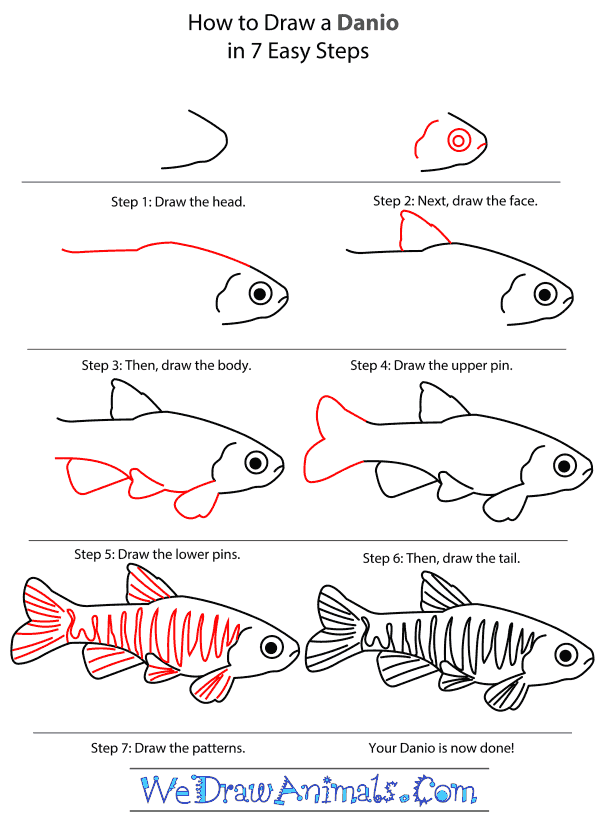In this quick tutorial you'll learn how to draw a Danio in 7 easy steps - great for kids and novice artists.
The images above represent how your finished drawing is going to look and the steps involved.
Below are the individual steps - you can click on each one for a High Resolution printable PDF version.
At the bottom you can read some interesting facts about the Danio.
Make sure you also check out any of the hundreds of drawing tutorials grouped by category.
How to Draw a Danio - Step-by-Step Tutorial
Step 1: Draw the head. It is a wide sideways "U". The bottom head line is slightly longer than the top.
Step 2: Draw a small line at the tip of the head to make the mouth line. Just behind the mouth draw a round eye. Draw another circle around the eye. Make a squiggly line between the top and bottom head lines to make the gill.
Step 3: Continue the top head line back to the left. Curve it to the left and continue in a straight line.
Step 4: At the top of the body line draw a triangle shaped fin.
Step 5: Now draw the 3 lower fins. The first fin starts just at the end of the bottom head line. It loops around to join up with the bottom of the gill line. The second fin is just to the left of the first fin. It is a triangle shape. Just to the left of the middle fin is the last fin. It sits below the belly line.
Step 6: Now draw the tail by bringing the top body line up to the left and the bottom body line down to the left. Bring those two lines back together so that the tail has a point at the top and one at the bottom.
Step 7: Finally draw the body patterns. There are long lines that run along the fins and the tail. Draw one long continuous squiggly line from the gill line back to the tail.
Interesting Facts about the DANIO
The Danio is a member of the fish group and the scientific term for them is Danio erythromicron. Danio is an Asian word that means “minnow-like” fish. The Greek word erythro-micron means “red-small” since the description represents the appearance of this fish. There are about a dozen black stripes that have a vertical placement along the entire length of their body. A key feature of this creature is a spot on the tail which appears as an eye, so that predators fail in consuming it by approaching the wrong end that quickly passes.
Did you know?
- This animal was first documented in 1918.
- This species is almost 1 inch in length.
- Their lakebed consists of about 40 percent sand, 40 percent silt, and 20 percent clay.
- The creature lives at almost 3,000 feet above sea level.
- Their swimming area was about 300 feet deep.
- The swimming area is currently almost 10 feet deep.
- The local human population has helped the fish since the 1300s.
Another name for this species is the Emerald Dwarf Rasbora. This animal is in the Cyprinid family, the most common type of fish. The creature is native to Inle Lake of Burma in Southeast Asia. The fish eats algae and zooplankton that feed on the aquatic crops of the people who live there. These animals have a low population amount, and are considered to be endangered to the possibility of extinction.











